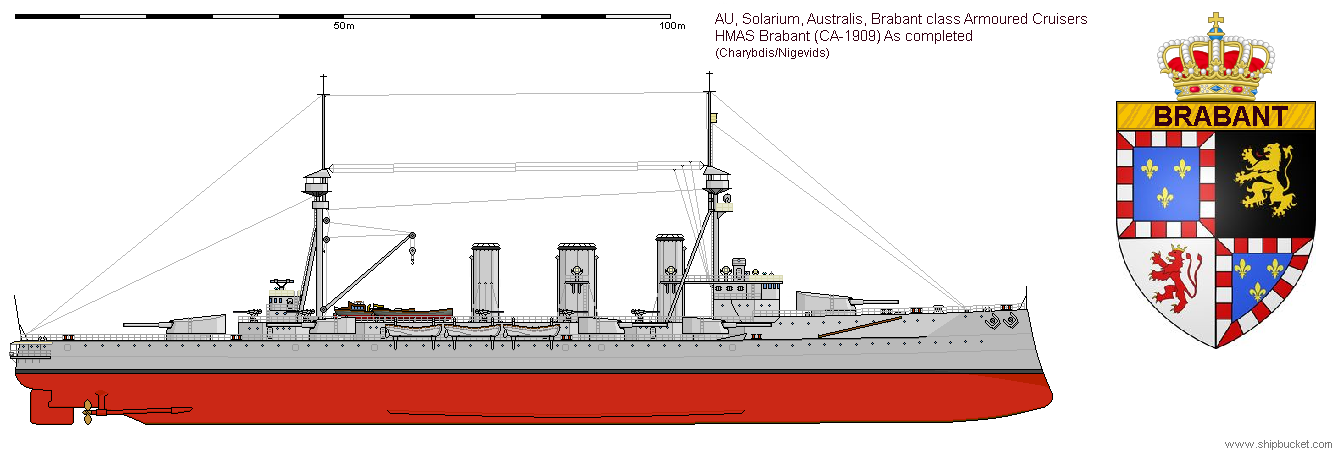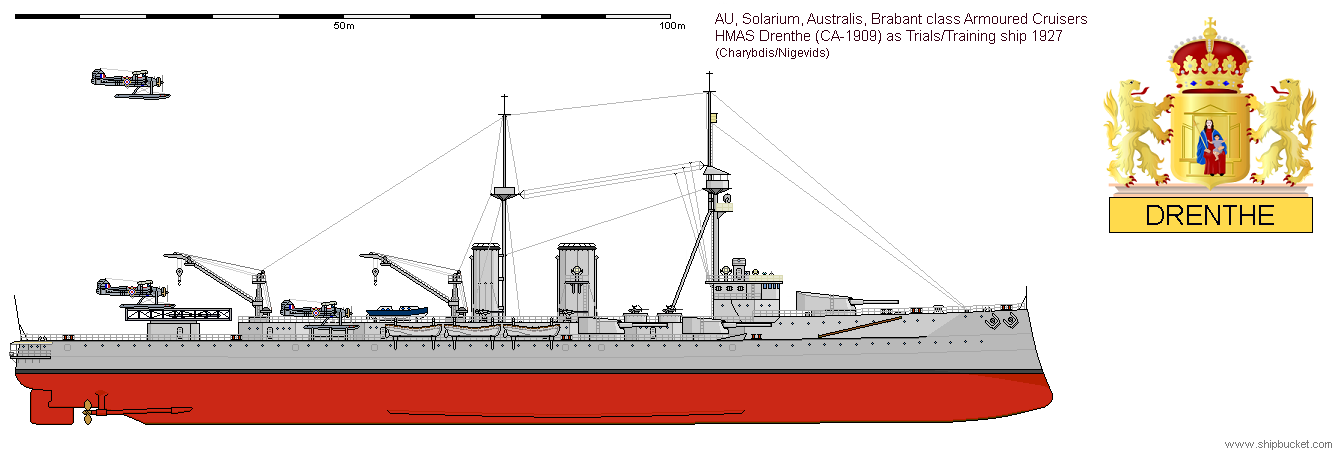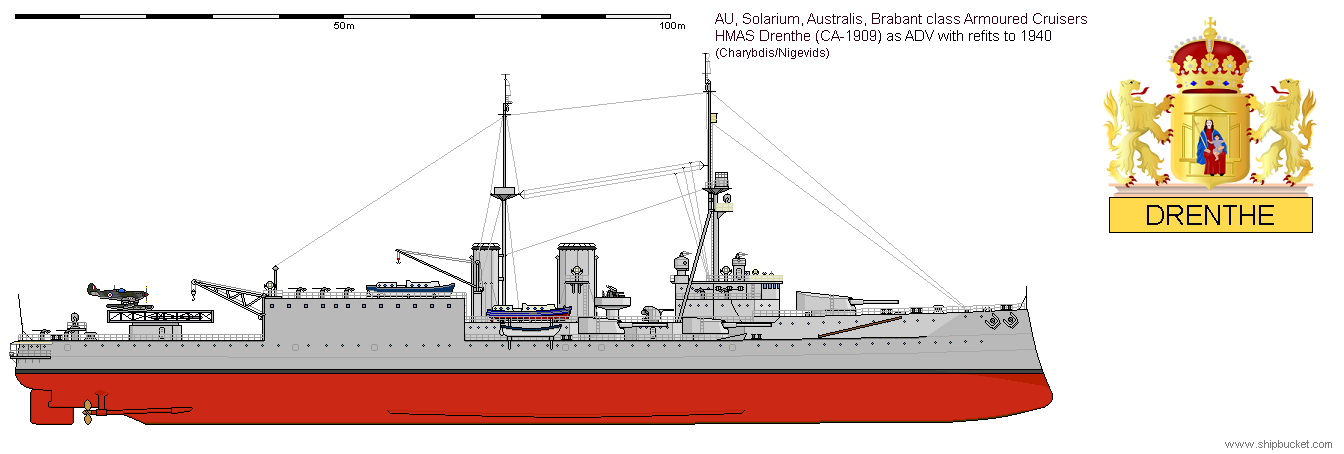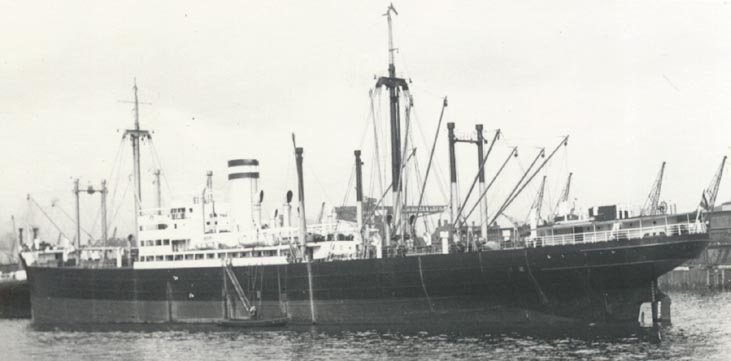The two Australis Navy armoured cruisers were supposed to be in line with the RN Duke/Minotaur Class with their mixed 9.2" and 7.5" guns. The Australis Navy delayed the design and construction several times as they were trying to find a balance between main and secondary weapons. One of the problems was the German Armoured cruiser main guns, the 8.2", outperformed the RN's 9.2", and the secondary RN 6" was not as good as the German 5.9". The RN's other intermediate gun sizes were the 10" and 7.5" guns. The 10" and 7.5" debuted in the RN on the Swiftsure and Triumph (sourced as Ex Chilean Battleships) with twin turrets fore and aft and the secondary 7.5" in single casemates. The 7.5" was too big to be hand loaded and worked with any degree of ease. That big a gun needed a turret with power options. The other problem with these 'intermediate' armed ships, was the shell splashes of the main and secondary weapons were hard to distinguish at long range.
The Royal Navy cured these problems with the Dreadnought and Invincible types. The Australis design was more in line with what their construction yards were capable of at the time. Rated as an Armoured cruiser the Brabant class pair of ships were later re-rated as battlecruisers after 1912 but were de-rated in 1920 to the new 'Heavy' cruiser designation. The armament was an all intermediate gun armament of ten 10" in twin and single mountings.

While the ships seemed powerful, losing three guns per broadside made them much less intimidating than the Invincible class that was built at a similar time. If the ten guns could all have been fire to each broadside, the two ships would have been much more lethal. If Australis had of waited a few more months before laying down the Brabant class, they could have followed the Leviathan and/or Forod-Waith designs. The best part of having waited an extra two years before commencing the building of these ships was the change in design from triple-expansion engines to turbines.
The Washington Treaty made these ships surplus as they would have had to have been counted in the 'Battleship' category as the new 'Cruiser' rating had a maximum of 10,000 tons while the Brabant class was 14,000 tons. The Australis Navy had three years to make up their minds what to do with the ships. By 1925, the Australis Navy, had decided to delete and scrap or sell all the very old ships that had previously been used as training ships and convert the Brabant and other modern yet obsolete ships to become the training ships. They would be especially useful as ocean going training ships with all of the Pacific as their playground.

The Drenthe was converted to a training ship in 1925 then in 1927 it also took on the role of trials ship for the new catapult units to be fitted to ships of all types in the future. 1930 and both the Brabant and Drenthe are earmarked for conversion to Area Defence Vessels. This conversion work was eventually carried out 1934-35 as some of the other older Australis ships had priority for dock space. This worked in the ships favour as the newer dual purpose guns were coming online and could be fitted in place of the older low angle weapons. A larger bridge superstructure was fitted to take the newer gun directors and the tripod mast fittings were modernised.

October 1940 and the Drenthe leaves the Adelaide dockyards after its latest round of refits and upgrades with orders to proceed to Diego Garcia and there to take command of the area and provide air cover around that area of the Perth to Aden shipping route. Diego Garcia is strategically placed about half way between Perth and Aden and has had a naval presence since the outbreak of war and Drenthe was to supply local patrols with its own aircraft and support for the squadron of long range flying boats based there. When the Japanese blow through the Indian Ocean in late 1941 early 1942, Diego Garcia was the 'secret' base of the Eastern Fleet.
On the way to Diego Garcia the Drenthe intercepted a suspicious merchantmen which when queried called itself the Dutch ship Nordenfels. A quick message to Transport Command revealed the Nordenfels was supposed to be in the South Atlantic (The HSK3 Widder had sunk the Nordenfels and taken its identity). Another message was sent to what turned out to be the merchant cruiser Widder, telling it to heave to and await boarding party. The Drenthe was at action stations and its 10" guns pointed at the Widder. The Widder started to drop its concealing plates and swing its three 5.9" guns out. The Drenthe opened fire. The Drenthe received four 5.9" hits in the ensuing exchange of gunfire, two hit the 6" armoured belt and did no damage, one hit the aft 10" face with its 6" angled armour and stunned the crew, the last hit was the most serious, hitting the thinly panelled hangar wall and passing through to destroy 3 of the four aircraft in the hangar and causing a fire that took hours to finally contain and douse, killing and wounding 40 crew. The Drenthe had its revenge. The large 550 pound shells of the Drenthe's 10" guns tore huge chunks out of the Widder. Five hits and the Widder was afire from stem to stern, two more hits and the ship started rolling on to its beam ends and capsizing. The Drenthe's two remaining large power boats and oared whalers were launched and sent to retrieve survivors. It was a race to who got there first, the rescuers, or the sharks. Unknown to the Drenthe's Captain, there were nearly 130 Allied merchant crewmen aboard the Widder, none of which survived as they had been locked below decks during the action, and went down with the ship. The Drenthe was ordered back to Perth to receive repairs and replacements for it losses during the battle.

HSK 3 Widder before transformation to a merchant cruiser.